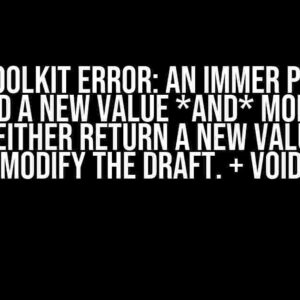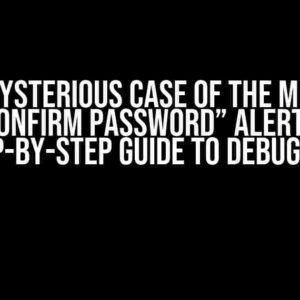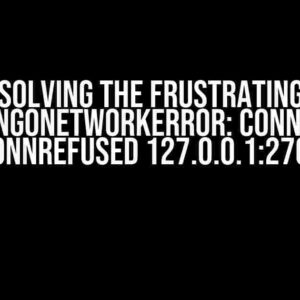Are you tired of dealing with the frustrating error code 0x800B010A when trying to deploy your app signed with custom certificates? Well, you’re in luck! In this article, we’ll dive deep into the world of certificate signing, explore the common causes of this error, and provide you with step-by-step solutions to get your app up and running in no time.
What is error code 0x800B010A?
The error code 0x800B010A is a generic error message that indicates a problem with the digital certificate used to sign your app. This error can occur when the certificate is not trusted, expired, or invalid, preventing your app from being installed or updated.
Common causes of error code 0x800B010A
Before we dive into the solutions, let’s take a look at some common causes of this error:
- Invalid or expired certificate: If your certificate has expired or is invalid, it will cause the error code 0x800B010A.
- Untrusted certificate authority: If the certificate authority that issued your certificate is not trusted by the operating system, you’ll encounter this error.
- Incorrect certificate format: Using the wrong certificate format, such as a .pfx file instead of a .cer file, can cause the error.
- Misconfigured certificate store: If the certificate store is not properly configured, it can lead to the error code 0x800B010A.
Solutions to fix error code 0x800B010A
Now that we’ve covered the common causes, let’s move on to the solutions!
Solution 1: Verify and update your certificate
First things first, verify that your certificate is valid and up-to-date. Check the expiration date and ensure it’s not expired. If it is, renew the certificate and obtain a new one from the certificate authority.
Certificate Expiration Date: 2025-02-15 14:30:00 UTC
If your certificate is valid, try updating it to the latest version to ensure it’s compatible with the latest operating system updates.
Solution 2: Install the certificate authority
Install the certificate authority that issued your certificate on the target machine. This will ensure that the operating system trusts the certificate authority and, in turn, your app’s certificate.
Certificate Authority: "My Company Certificate Authority" Issued by: "My Company"
Use the following steps to install the certificate authority:
- Open the Certificates snap-in (certmgr.msc)
- Right-click on the “Trusted Root Certification Authorities” folder and select “All Tasks” > “Import…”
- Select the certificate authority file (.cer or .crt) and follow the wizard to install it.
Solution 3: Configure the certificate store
Misconfigured certificate stores can cause a range of issues, including the error code 0x800B010A. Ensure that the certificate store is properly configured and that the certificates are installed in the correct location.
| Certificate Type | Store Location |
|---|---|
| Root Certificate | Trusted Root Certification Authorities |
| Intermediate Certificate | Intermediate Certification Authorities |
| Client Certificate | Personal |
Use the following steps to configure the certificate store:
- Open the Certificates snap-in (certmgr.msc)
- Verify that the certificates are installed in the correct location.
- Check for any duplicate certificates and remove them.
Solution 4: Sign the app with the correct certificate
Ensure that your app is signed with the correct certificate. Double-check the certificate format, and make sure you’re using the correct certificate for signing.
Signing Certificate: "My Company App Certificate" Format: .pfx
Use the following steps to sign your app:
- Open the Visual Studio solution.
- Right-click on the project and select “Properties”.
- Navigate to the “Signing” tab.
- Select the correct certificate from the “Choose a certificate” dropdown.
Conclusion
Error code 0x800B010A can be a frustrating and elusive issue to resolve, but by following the solutions outlined in this article, you should be able to identify and fix the root cause of the problem. Remember to verify and update your certificate, install the certificate authority, configure the certificate store, and sign the app with the correct certificate.
By following these steps, you’ll be able to overcome the error code 0x800B010A and get your app up and running in no time. Happy coding!
Frequently Asked Questions
Q: What is a custom certificate?
A: A custom certificate is a digital certificate issued by a certificate authority that is not a trusted root certification authority. Custom certificates are often used for internal testing or development purposes.
Q: How do I obtain a custom certificate?
A: You can obtain a custom certificate from a certificate authority or by generating a self-signed certificate using tools like OpenSSL.
Q: Can I use a self-signed certificate for my app?
A: While it’s possible to use a self-signed certificate, it’s not recommended for production environments. Self-signed certificates are not trusted by default and may cause issues with your app’s installation and updates.
Additional Resources
For further reading and troubleshooting, check out the following resources:
By following the solutions outlined in this article and consulting the additional resources, you should be able to overcome the error code 0x800B010A and ensure that your app is successfully deployed with custom certificates.
Frequently Asked Question
Stuck with the frustrating error code 0x800B010A while using an app signed with custom certificates? Worry not, we’ve got you covered!
What does error code 0x800B010A mean?
Error code 0x800B010A typically indicates that the app’s digital certificate is invalid, revoked, or expired. This prevents the app from installing or running, ensuring the user’s safety and security.
Why does my custom certificate cause the 0x800B010A error?
There are several reasons why your custom certificate might be causing the error. Common culprits include incorrect certificate configuration, missing intermediate certificates, or an invalid certificate chain. It’s also possible that your certificate is not trusted by the operating system or has been revoked.
How can I troubleshoot the 0x800B010A error?
To troubleshoot the error, start by verifying that your custom certificate is correctly configured and valid. Check the certificate chain, ensure all intermediate certificates are installed, and confirm that the certificate has not been revoked. You can also try installing the app on a different device or checking the app’s installation logs for more detailed error messages.
Can I bypass the 0x800B010A error and install the app anyway?
We strongly advise against bypassing the error and installing the app anyway. The 0x800B010A error is a security mechanism designed to protect users from potentially malicious apps. Ignoring the error could compromise your device’s security and put your data at risk. Instead, work with the app developer to resolve the certificate issue.
What is the best way to resolve the 0x800B010A error?
The best way to resolve the error is to obtain a valid and trusted certificate from a reputable certificate authority. Ensure the certificate is correctly configured, and all intermediate certificates are installed. If you’re still experiencing issues, consult with the app developer or a qualified IT professional for further assistance.





